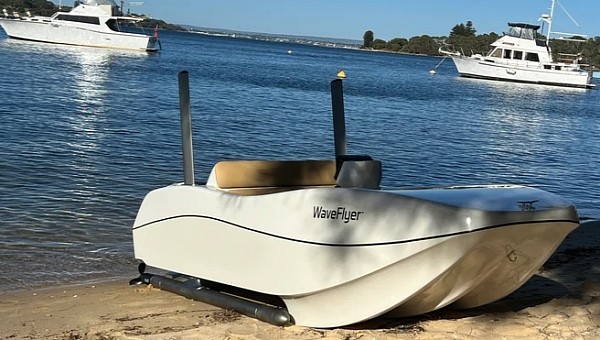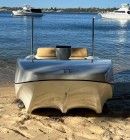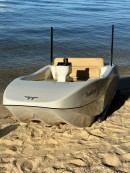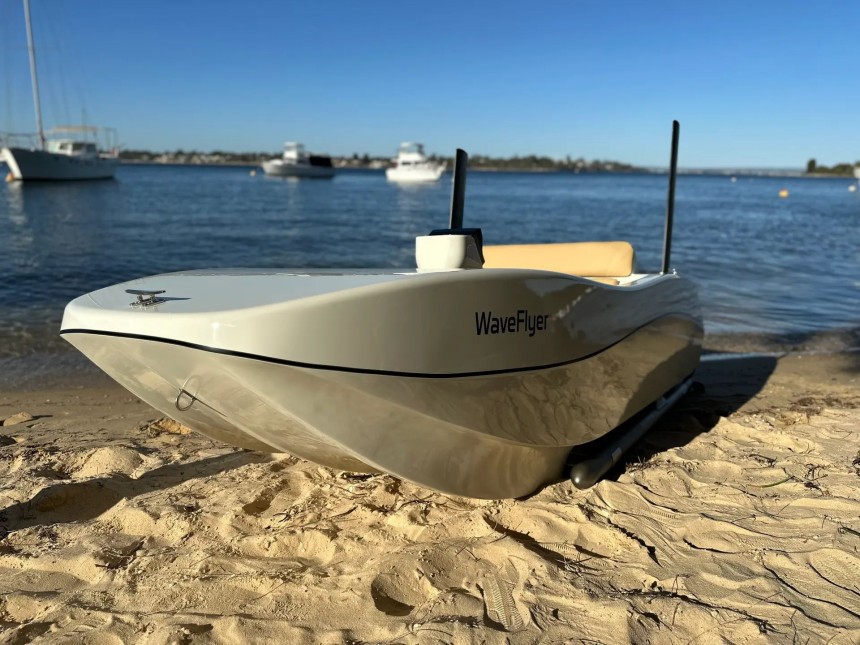Jet skis ride on the water as smoothly as motorbikes on highways. If they are also equipped with hydrofoils and electric propulsion, they will cut through the water and rise above the waves with less friction, increased speed, and reduced noise. The WaveFlyer Volare combines all the above elements to offer a more environmentally-friendly and quieter ride.
Developed by Australia-based Electro Nautic, the WaveFlyer Volare is a two-seater electric hydrofoil that will be showcased at the Fully Charged Live event in Sydney between March 11-12.
The WaveFlyer watercraft was first unveiled in 2019 in prototype form, and back then, it was just a hydrofoil system in the early stages of development fitted to a jet ski. In its long journey from concept to production, it suffered significant changes. It now looks like a small, elegant tender boat that can accommodate two riders sitting side by side.
“At Electro Nautic, we are a small team of passionate individuals who have brought together world-leading technology to create the WaveFlyer Volare,” says Joshua Portlock, the company’s co-founder and CEO. “We are proud to showcase our Australian innovation to the world and demonstrate what can be achieved with determination, perseverance and a vision for a sustainable future.”
The personal electric watercraft weighs 440 pounds (200 kg) and can hit a top speed of 25 mph (40 kph). According to the company, while foiling, the WaveFlyer can offer a range of 62 miles (100 km).
Featuring a body that extends down from the hull in what the company calls the world’s first A-tail layout, the hydrofoil will rise and glide about 2.3 ft (70 cm) above the water’s surface once it reaches speed. This is made possible by its unique aerodynamic design and twin electric hydrofoil propulsion system that combine to provide unmatched active stability and maneuverability. A fly-by-wire control system balances the watercraft at all times to avoid unpleasant incidents at high speed.
Joshua Portlock explains that the combination of hydrofoils with electric propulsion and active stability control systems means that the WaveFlyer Volare watercraft uses 75% less power than conventional boat hulls to move over water. This significant power saving means four times more range for an electric boat with the same battery capacity.
Volare’s electric propulsion units are fitted at the back of its retractable foils. When at rest or in shallow waters, these foils lift up level with the hull. In this position, the craft looks like a traditional jet ski, but as it glides through the water and reaches speed, its body rises up with the twin hydrofoil propulsion system slicing through the waves.
As mentioned, the WaveFlyer is small and light, measuring just 9.5 ft (290 cm) long and 4.1 ft (125 cm) wide, and sports comfortable-looking seats for two riders. It also features a 7-inch digital display and a control joystick placed in the middle.
Three riding modes are available: Cruise Mode, Performance Mode, and Shallow-Water Mode. The craft’s integrated software can switch from smooth cruising to dynamic performance, which will feel like piloting a fighter jet on the water. The Shallow-Water Mode is kind of self-explanatory - with its foils retracted, it will navigate shallow water like a normal boat.
Also worth noting is that the fly-by-wire system supports remote control, meaning you’ll be able to control the WaveFlyer using a phone app, and it will have a built-in geofencing feature to avoid navigating to restricted areas.
Electro Nautic has opened the pre-order books for the WaveFlyer Volare, with the base model, which will offer riders 1.5 hours of fun (up to 22 miles/ 35 km), will be priced at $49,990. The range-topper promises 4.5 hours and 62 miles (100 km) for $59,990.
The WaveFlyer watercraft was first unveiled in 2019 in prototype form, and back then, it was just a hydrofoil system in the early stages of development fitted to a jet ski. In its long journey from concept to production, it suffered significant changes. It now looks like a small, elegant tender boat that can accommodate two riders sitting side by side.
“At Electro Nautic, we are a small team of passionate individuals who have brought together world-leading technology to create the WaveFlyer Volare,” says Joshua Portlock, the company’s co-founder and CEO. “We are proud to showcase our Australian innovation to the world and demonstrate what can be achieved with determination, perseverance and a vision for a sustainable future.”
The personal electric watercraft weighs 440 pounds (200 kg) and can hit a top speed of 25 mph (40 kph). According to the company, while foiling, the WaveFlyer can offer a range of 62 miles (100 km).
Featuring a body that extends down from the hull in what the company calls the world’s first A-tail layout, the hydrofoil will rise and glide about 2.3 ft (70 cm) above the water’s surface once it reaches speed. This is made possible by its unique aerodynamic design and twin electric hydrofoil propulsion system that combine to provide unmatched active stability and maneuverability. A fly-by-wire control system balances the watercraft at all times to avoid unpleasant incidents at high speed.
Joshua Portlock explains that the combination of hydrofoils with electric propulsion and active stability control systems means that the WaveFlyer Volare watercraft uses 75% less power than conventional boat hulls to move over water. This significant power saving means four times more range for an electric boat with the same battery capacity.
Volare’s electric propulsion units are fitted at the back of its retractable foils. When at rest or in shallow waters, these foils lift up level with the hull. In this position, the craft looks like a traditional jet ski, but as it glides through the water and reaches speed, its body rises up with the twin hydrofoil propulsion system slicing through the waves.
As mentioned, the WaveFlyer is small and light, measuring just 9.5 ft (290 cm) long and 4.1 ft (125 cm) wide, and sports comfortable-looking seats for two riders. It also features a 7-inch digital display and a control joystick placed in the middle.
Three riding modes are available: Cruise Mode, Performance Mode, and Shallow-Water Mode. The craft’s integrated software can switch from smooth cruising to dynamic performance, which will feel like piloting a fighter jet on the water. The Shallow-Water Mode is kind of self-explanatory - with its foils retracted, it will navigate shallow water like a normal boat.
Also worth noting is that the fly-by-wire system supports remote control, meaning you’ll be able to control the WaveFlyer using a phone app, and it will have a built-in geofencing feature to avoid navigating to restricted areas.
Electro Nautic has opened the pre-order books for the WaveFlyer Volare, with the base model, which will offer riders 1.5 hours of fun (up to 22 miles/ 35 km), will be priced at $49,990. The range-topper promises 4.5 hours and 62 miles (100 km) for $59,990.










